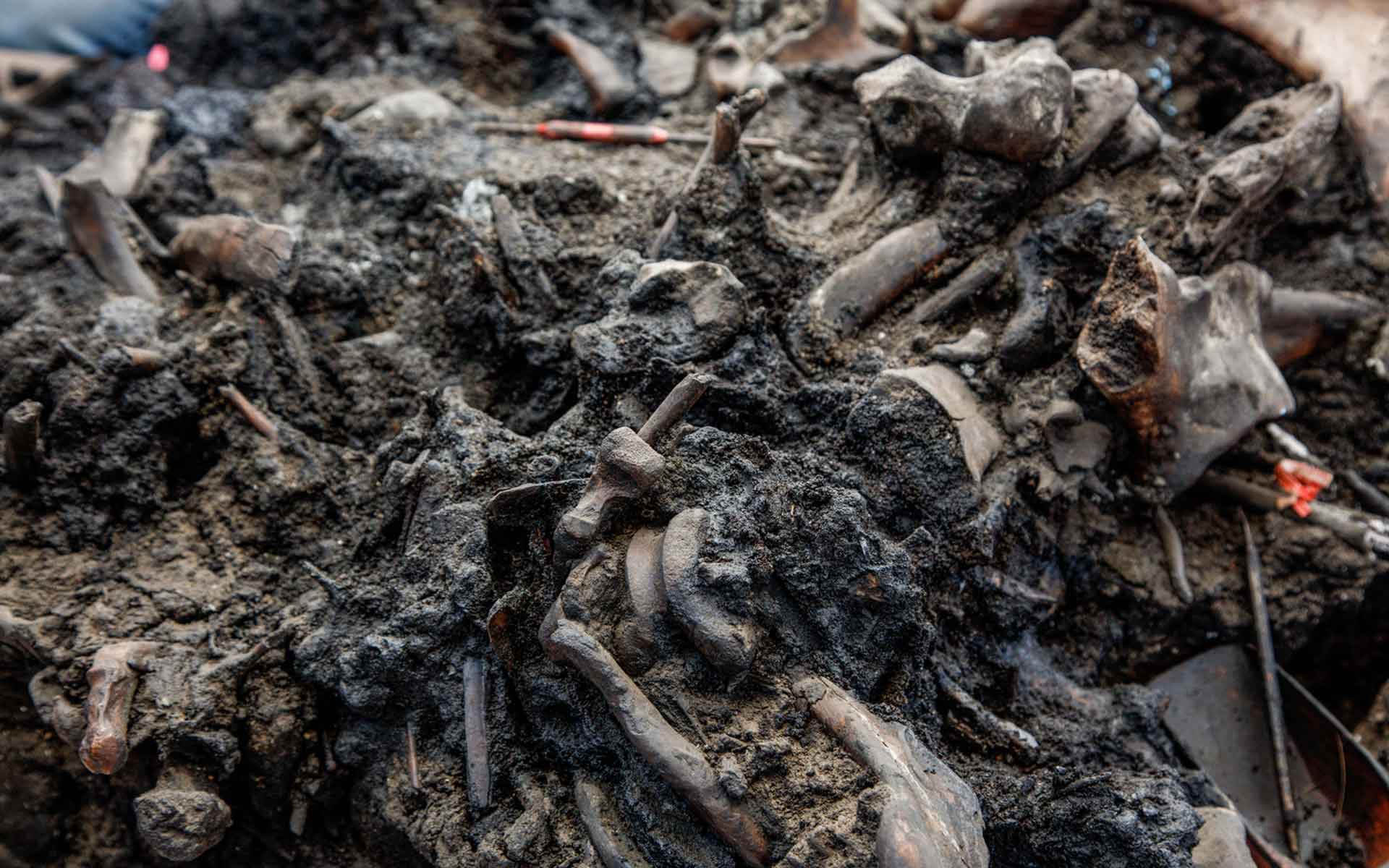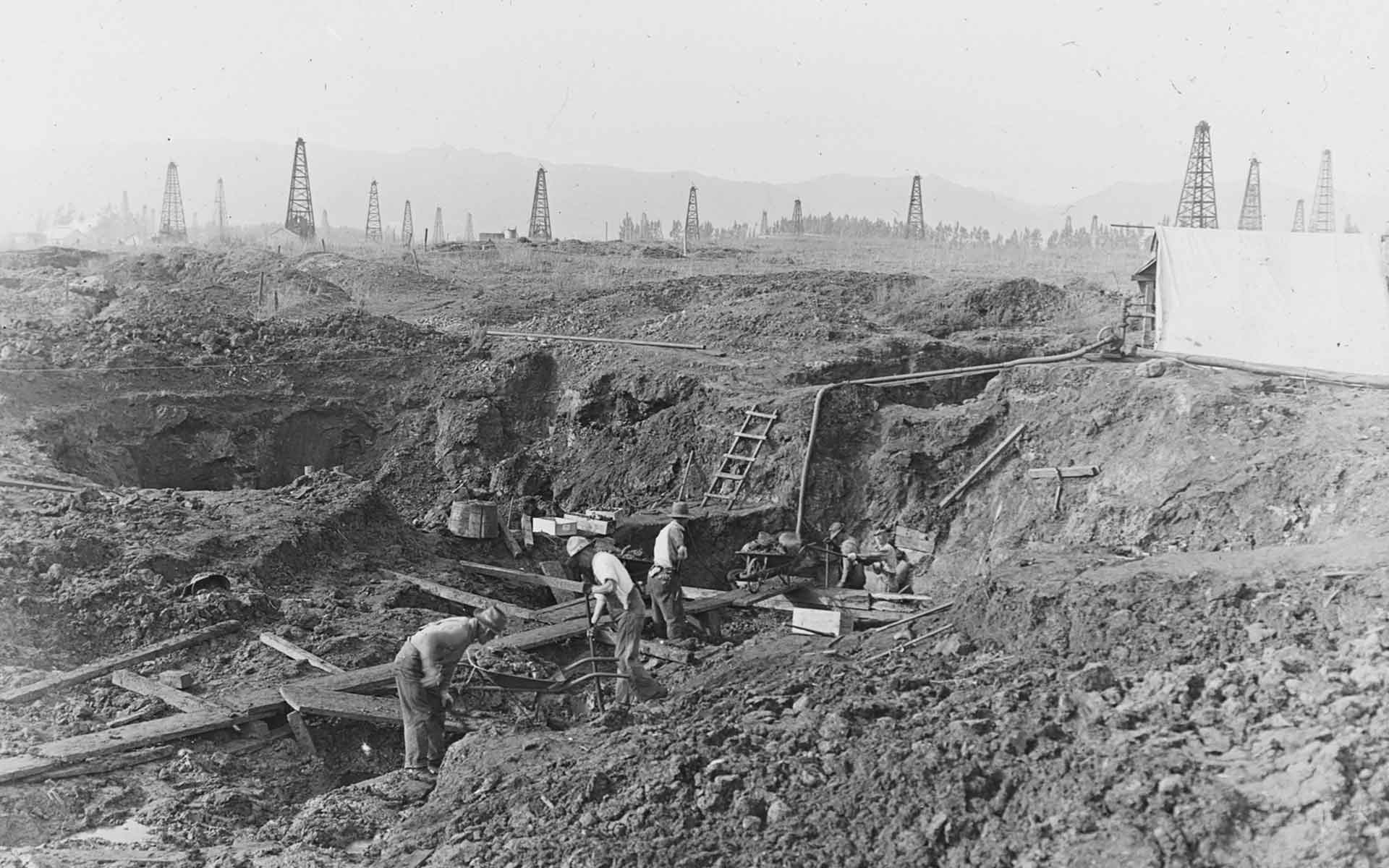Late Quaternary Asphalt Seeps and Paleontological site of La Brea Tar Pits
USA

Mass of Late Quaternary fossils preserved in an asphaltic deposit at Rancho La Brea exposed during 2017 excavations. (©Natural History Museum of Los Angeles County).
Geological Period
Late Pleistocene – Holocene
Main geological interest
Paleontology
Location
Los Angeles, California, United States.
34°03’50.0″N, 118°21’20.0″W
Mass of Late Quaternary fossils preserved in an asphaltic deposit at Rancho La Brea exposed during 2017 excavations. (©Natural History Museum of Los Angeles County).
The richest paleontological site on Earth for terrestrial fossils of Late Quaternary age.
Long recognized as one of the most important fossil localities in the world, the asphaltic deposits collectively known as the La Brea Tar Pits have been the subject of intensive research on geology, paleontology, and archaeology for over 150 years. In 1951 this locality was designated as the type locality for the Rancholabrean North American Land Mammal Age (NALMA). The site was formally recognized by the United States National Parks Service as a National Natural Landmark in 1963.
- Geological description
Los Angeles, California, sits atop a sedimentary basin bounded by the Transverse and Peninsular ranges. On the northern part of the basin lies an alluvial plain shed from the Santa Monica Mountains during the Pleistocene. In the vicinity of La Brea Tar Pits (Rancho La Brea), 45 meters of this alluvium, referred to as the Palos Verdes Sand, rests upon Middle Pleistocene shallow marine strata and thick, oil-rich Middle Miocene deep-marine deposits. Through multiple intervals of uplift and faulting, crude petroleum has seeped to the surface over the last ~60,000 years, forming shallow pools that have entrapped and preserved millions of fossils representing hundreds of species of plants, invertebrates, and vertebrates. These fossil remains, ranging from Mammuthus, Smilodon, and entire Juniperus trunks to seeds, insects and songbirds, form a continuous record of ecosystem structure and change across major climatic and geological boundaries. The asphaltic fossil preservation is so exquisite that original biotic materials including collagen, cellulose, and chitin are preserved, allowing geochemical analyses including radiocarbon dating and studies of stable isotopic signatures. The Rancho La Brea Lagerstätte therefore represents a unique opportunity to study the impacts of Earth processes like climate change on ecosystem dynamics, species adaptations, and extinction.
- Scientific research and tradition
More than four million fossil specimens have been excavated since the site’s discovery in 1875. These collections, and the locality itself, have been the subject of more than 400 scientific publications. Ongoing excavations, a growing collection, and evolving research techniques continue to yield new insights about Late Quaternary ecosystems.
- Reference
Merriam, J.C. and Stock, C. (1932) The Felidæ of Rancho La Brea. Washington, D.C.: Carnegie Institution of Washington (Carnegie Institution of Washington Publication, 422).
Mychajliw, A.M. et al. (2020) ‘Exceptionally preserved asphaltic coprolites expand the spatiotemporal range of a North American paleoecological proxy’, Scientific Reports, 10(1), p. 5069. Available at: https://doi.org/10.1038/s41598-020-61996-y.
Stock, C. and Harris, J.M. (1992) Rancho la Brea: A record of Pleistocene life in California. Los Angeles: Natural History Museum of Los Angeles County (Natural History Museum Los Angeles County, Science series, 37).
Ward, J.K. et al. (2005) ‘Carbon starvation in glacial trees recovered from the La Brea tar pits, southern California’, Proceedings of the National Academy of Sciences of the United States of America, 102(3), pp. 690–694. Available at: https://doi.org/10.1073/pnas.0408315102.
Woodard, G.D. and Marcus, L.F. (1973) ‘Rancho La Brea Fossil Deposits: A Re-Evaluation from Stratigraphic and Geological Evidence’, Journal of Paleontology, 47(1), pp. 54–69.
- Author(s)
Regan E. Dunn
Assistant Curator, La Brea Tar Pits, Natural History Museum of Los Angeles County
Emily L. Lindsey
Associate Curator & Excavation Site Director, La Brea Tar Pits, Natural History Museum of Los Angeles County
Luis M. Chiappe
Senior Vice President, Research & Collections, Gretchen Augustyn Director, Dinosaur Institute, Natural History Museum of Los Angeles County
Shana Mathur
Chief Strategy & External Relations Officer, Marketing & Communications, Natural History Museum of Los Angeles County
Yolanda Bustos
Museum Archivist, Research & Collections, Research Library, Natural History Museum of Los Angeles County
Jenn Berger
Digital Asset Manager, Creative Services, Natural History Museum of Los Angeles County
Lori Bettison-Varga
President and Director, Natural History Museum of Los Angeles County


